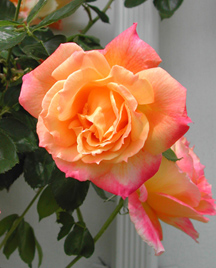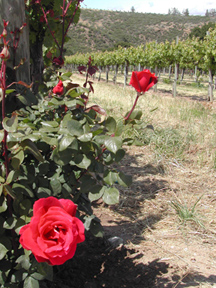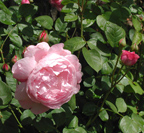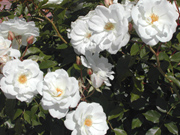 Bay CrossingsGardens
Bay CrossingsGardens
Roses - No Pain No Gain
By Botany Bob
No more be griev’d at that which thou hast
done:
Roses have thorns, and silver fountains mud;
Clouds and eclipses stain both moon and sun,
And loathsome canker lives in sweetest bud.
So begins Shakespeare’s Sonnet 35, a balm for the soul as
roses are a remedy for the spirit. For some, growing roses
is akin to losing the prize, a thing of love most sought
after—all those pesticides to keep away molds and aphids
(particularly horrible this season, since unseasonable warm
dry weather coupled with wind stessed tiny buds
excessively).
Why bother? Just pick up a bouquet on the
way to the supermarket, or if the budget allows, the
florist. But there is something ineluctably rewarding about
growing them in your own garden or container, a striving for
perfection perhaps, even an award winner.
 |
| Joseph’s
Couth |
Suggestions for Growing Great Roses
As hard as it may be, one should accept the fact that your
microclimate may not allow you to grow the roses you
prominently see featured in glossy-covered magazines. The
genealogy of many of the hybrids is very complex. A drive
through Napa-Sonoma in the dry heat of summer shows roses
resplendent in bloom. According to Mary Swift-Swan, these
roses are planted as indicators of the presence of danger,
like the canary in the coal mine; if the roses get sick, the
next thing may be the vinyards. But it is a fact that dry,
warm, and sunny conditions make roses relatively easy to
grow. California has always been associated with the best
roses, and in the past has supplied the nation for funerals
and weddings. During the winter, when energy costs were low,
they were grown in greenhouses; but today, land is either
turned over for real estate or a lower temperature demanding
crop like snapdragons or stock is grown. Giving snapdragons
to one’s sweetie just isn’t the same.
Soil
A deep, rich, well-composted medium suits roses very well.
The first step in helping to aerate heavy clay soil is to
incorporate gypsum followed by gypsum and peat moss or
better yet, from a renewable source, such as leaf mold,
earthworm castings, and well- fallowed (allowed to compost
for at least a year) manures. The resulting medium should
drain well and be slightly acidic with a pH of 6.4 to 6.7.
In lime based clays, such as exist along the coast, water
tends to be somewhat basic and over time the pH tends to
creep up above 7, which is the reason those blue Hydrangeas
keep coming out pink.
 |
| Lincon
Rose |
Water
Roses respond to consistent moisture, but this does not mean
using half of Hetch-Hetchy to grow them. It is possible to
suffocate the tiny root hairs (made up of only one cell)
with over watering.
Infestations
For the most susceptible roses, a regular disease and bug
prevention program should be conducted at least bi-weekly,
and with inconstant weather such as wind and heavy fog, once
a week. The best bet is to have a one-gallon sprayer
designated for the purpose, and purchase the concentrated
product such as Neem oil (derived from a tropical tree), or
pyrethrins( derived from a South African member of the
Chrysanthemum family). Neem oil controls both disease and
pests, while pyrethrins controls only pests. Two to three
tablespoons of Neem oil per gallon may be required to
control diseases and thrips. If one has only a few roses,
there are pre-prepared solutions containing both pyrethrins
and Neem oil within a spray bottle.
 |
| Heritage
Rose |
Air Flow
Good ventilation is one of the most overlooked limiting
factors in growing any plant.
Roses easily can become an obsession and the desire to
collect more and more compulsive. Beware and forewarned.
Plant your bushes at least five feet apart, or further for
an especially large variety such as Trier or Rambling
Rector, which can cover an entire tree.
Disease-Resistant Roses
Ever heard of a rose rustler. There is actually a group that
stealthily goes into wild and abandoned places searching for
roses that have been growing vigorously without signs of
disease or serious pests, in some cases roses that are well
over a hundred years. They pirate old graveyards, open
spaces, and occasionaly derelict properties. Below, I have
made a list of both modern and some heirloom roses that
succeed almost anywhere along our foggy western coast.
Pink
Eden: Both bush and climber, often cited as the most
disease-resistant, fabulously full rose in America.
Sheer Bliss: Good disease resistance. magnificent form and
color.
First Prize: Good disease resistance, full large pink.
 |
| Iceberg
Rose |
Mlle. Cecile Brunner: At least three forms, two of which
bloom prolifically six times a summer. Few thorns, excellent
disease resistance; a pillar rose and one climbing form.
Zephrin Drouhin: Blooms in bright shade, heavenly fragrance,
virtually no thorns, excellent disease resistance. Who could
ask for anything more.
Rosa chinensis var. mutabilis: Apricot, pink, white, small
butterflies all on the same climber. Can be grown through
other plants such as star jasmine.
Red
Altissimo: Large brightest red single pillar rose, can be
trained as a climber, no blood red hues at all, fabulous.
Dublins Bay: (climber and bush) Mutation of Altissimo, but
double brighest non- sanguine red (see picture).
Mr Lincoln: Hybrid Tea: Luscious full, slightly sanguine
red, moderate disease resistance. A magnificent rose.
Olympiad: Open bush developed in commeration of the LA
Olympics. (See picture in vineyard.)
Trumpeter: Floribunda: One of the best all-around orange-red
roses for landscape use. Extremely disease resistant.